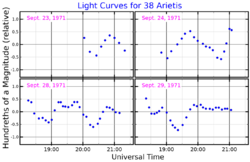Astronomy:38 Arietis
| Observation data Equinox J2000.0]] (ICRS) | |
|---|---|
| Constellation | Aries |
| Right ascension | 02h 44m 57.57945s[2] |
| Declination | +12° 26′ 44.7297″[2] |
| Apparent magnitude (V) | +5.178[3] |
| Characteristics | |
| Spectral type | A7 III-IV[4] |
| U−B color index | +0.121[3] |
| B−V color index | +0.235[3] |
| Variable type | δ Sct[5] |
| Astrometry | |
| Radial velocity (Rv) | -1.5[6] km/s |
| Proper motion (μ) | RA: +120.49[2] mas/yr Dec.: -85.78[2] mas/yr |
| Parallax (π) | 27.52 ± 0.40[2] mas |
| Distance | 119 ± 2 ly (36.3 ± 0.5 pc) |
| Absolute magnitude (MV) | 2.22[7] |
| Details | |
| Radius | 2.1[8] R☉ |
| Luminosity | 11[7] L☉ |
| Surface gravity (log g) | 4.04[7] cgs |
| Temperature | 7,638[7] K |
| Rotational velocity (v sin i) | 86[9] km/s |
| Age | 0.58[10] Gyr |
| Other designations | |
| Database references | |
| SIMBAD | data |
38 Arietis (abbreviated 38 Ari) is a variable star in the northern constellation of Aries. 38 Arietis is the Flamsteed designation. It was once designated 88 Ceti,[12] forming part of the neighboring constellation of Cetus. With an apparent visual magnitude of +5.18,[3] it is bright enough to be viewed with the naked eye. The measured annual parallax shift of 27.52 mas[2] is equivalent to a distance of approximately 119 light-years (36 parsecs) from Earth.
The spectrum of this star matches a stellar classification of A7 III-IV,[4] with the luminosity class of III-IV indicating it shows traits part way between the subgiant and giant star stages of its evolution. It is a Delta Scuti variable with a period of 0.0355 days (51 minutes) and a magnitude change of 0.040.[5] This star is larger than the Sun, with more than double the Sun's radius and 11 times the luminosity.[7] This energy is being radiated into outer space from the atmosphere at an effective temperature of 7,638 K,[7] giving it the white-hued glow of an A-type star.
References
- ↑ Valtier, J. C.; Sareyan, J. P.; Le Contel, J. M.; Zribi, G. (January 1974). "Photometric observations of delta Scuti stars. II. HR 432, HR 515, HR 812". Astronomy & Astrophysics Supplement Series 18: 235–249. http://articles.adsabs.harvard.edu/pdf/1974A%26AS...18..235V. Retrieved 28 October 2021.
- ↑ 2.0 2.1 2.2 2.3 2.4 2.5 van Leeuwen, F. (November 2007), "Validation of the new Hipparcos reduction", Astronomy and Astrophysics 474 (2): 653–664, doi:10.1051/0004-6361:20078357, Bibcode: 2007A&A...474..653V.
- ↑ 3.0 3.1 3.2 3.3 Gutierrez-Moreno, Adelina et al. (1966), "A System of photometric standards", Publications of the Department of Astronomy University of Chile (Publicaciones Universidad de Chile, Department de Astronomy) 1: 1–17, Bibcode: 1966PDAUC...1....1G.
- ↑ 4.0 4.1 Cowley, A. et al. (April 1969), "A study of the bright A stars. I. A catalogue of spectral classifications", Astronomical Journal 74: 375–406, doi:10.1086/110819, Bibcode: 1969AJ.....74..375C.
- ↑ 5.0 5.1 Rodríguez, E.; López-González, M. J.; López de Coca, P. (June 2000), "A revised catalogue of delta Sct stars", Astronomy and Astrophysics Supplement Series 144 (3): 469–474, doi:10.1051/aas:2000221, Bibcode: 2000A&AS..144..469R.
- ↑ Wilson, R. E. (1953), "General Catalogue of Stellar Radial Velocities", Carnegie Institute Washington D.C. Publication (Carnegie Institute of Washington D.C.), Bibcode: 1953GCRV..C......0W.
- ↑ 7.0 7.1 7.2 7.3 7.4 7.5 Paunzen, E. et al. (September 2002), "On the Period-Luminosity-Colour-Metallicity relation and the pulsational characteristics of lambda Bootis type stars", Astronomy and Astrophysics 392 (2): 515–528, doi:10.1051/0004-6361:20020854, Bibcode: 2002A&A...392..515P.
- ↑ Pasinetti Fracassini, L. E.; Pastori, L.; Covino, S.; Pozzi, A. (February 2001). "Catalogue of Apparent Diameters and Absolute Radii of Stars (CADARS) - Third edition - Comments and statistics". Astronomy and Astrophysics 367 (2): 521–524. doi:10.1051/0004-6361:20000451. Bibcode: 2001A&A...367..521P.
- ↑ Royer, F. et al. (October 2002), "Rotational velocities of A-type stars in the northern hemisphere. II. Measurement of v sin i", Astronomy and Astrophysics 393: 897–911, doi:10.1051/0004-6361:20020943, Bibcode: 2002A&A...393..897R.
- ↑ Vican, Laura (June 2012), "Age Determination for 346 Nearby Stars in the Herschel DEBRIS Survey", The Astronomical Journal 143 (6): 135, doi:10.1088/0004-6256/143/6/135, Bibcode: 2012AJ....143..135V.
- ↑ "38 Ari". SIMBAD. Centre de données astronomiques de Strasbourg. http://simbad.u-strasbg.fr/simbad/sim-basic?Ident=38+Ari.
- ↑ Wagman, M. (August 1987), "Flamsteed's Missing Stars", Journal for the History of Astronomy 18 (3): 215, doi:10.1177/002182868701800305, Bibcode: 1987JHA....18..209W.
External links
 |


